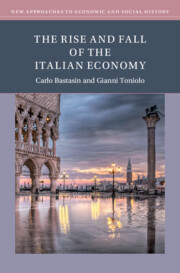Book contents
- The Rise and Fall of the Italian Economy
- New Approaches to Economic and Social History
- The Rise and Fall of the Italian Economy
- Copyright page
- Dedication
- Contents
- Figures
- Tables
- Preface
- 1 Italy’s Parabola, 1861–2022
- 2 Slow Economic Unification, 1861–1896
- 3 Convergence and Sorpasso
- 4 The Trauma of 1992
- 5 The Lost Opportunity, 1996–2007
- 6 Sliding toward Zero Growth
- 7 The Canary in the Coalmine
- Notes
- References
- Index
7 - The Canary in the Coalmine
Published online by Cambridge University Press: 24 August 2023
- The Rise and Fall of the Italian Economy
- New Approaches to Economic and Social History
- The Rise and Fall of the Italian Economy
- Copyright page
- Dedication
- Contents
- Figures
- Tables
- Preface
- 1 Italy’s Parabola, 1861–2022
- 2 Slow Economic Unification, 1861–1896
- 3 Convergence and Sorpasso
- 4 The Trauma of 1992
- 5 The Lost Opportunity, 1996–2007
- 6 Sliding toward Zero Growth
- 7 The Canary in the Coalmine
- Notes
- References
- Index
Summary
This chapter recapitulates the findings, showing how financial and political instabilities feed into each other. We show the correlations between financial instability and the fall in investment and between a stagnating economy and the loss of trust in the stability of the democratic system. Italy is the only case so far of a “high-income trap” leading to long-term economic decline. The resilience after the pandemic crisis testifies to two prospective fields of research: the lack of credibility in the national institutions was successfully complemented by the European institutions. The vibrancy of the economy remains as a century-old attitude of Italians: a self-defense mechanism, rooted in centuries of skepticism versus public authorities. This might be a relevant factor in the survival of liberal democracies.
- Type
- Chapter
- Information
- The Rise and Fall of the Italian Economy , pp. 144 - 155Publisher: Cambridge University PressPrint publication year: 2023

